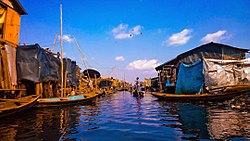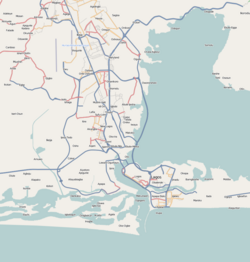Makoko | |
|---|---|
Informal Settlement | |
 A landscape photo of Makoko, 2017. | |
| Coordinates: 6°29′44″N3°23′39″E / 6.49556°N 3.39417°E | |
| Country | Nigeria |
| State | Lagos State |
| Slum | Lagos |
| LGA | Lagos Mainland |
| Settled | 19th century |
| Population (2020) [1] | |
• Total | 85,000 – 1,000,000 |
| Time zone | UTC+1 |
Makoko is an informal settlement across the 3rd Mainland Bridge located on the coast of mainland Lagos, Nigeria. A third of the community is built on stilts along the lagoon and the rest is on the land. The waterfront part of the community is largely harboured by the Egun people who migrated from Badagary and Republic of Benin and whose main occupation is fishing.
Contents
Makoko comprises six individual villages, of which four are floating communities (Adogbo, Migbewhe, Oko Agbon and Yanshiwhe) and two are on land (Apollo and Sogunro).The state government of Lagos refers to the area as Makoko-Iwaya Waterfront. [2]
Makoko is sometimes referred to as the "Venice of Africa" owing to its waterways. [3] Its population is considered to be 85,840; however, the area was not officially counted as part of the 2007 census and the population has been estimated to be much higher – as high as over a million in 2020. [1] [4] In July 2012, the Lagos State government ordered that some of the stilts beyond the power lines be brought down without proper notice. This led to the destruction of several stilts on the Iwaya/Makoko waterfront and many families were rendered homeless. [5]
















